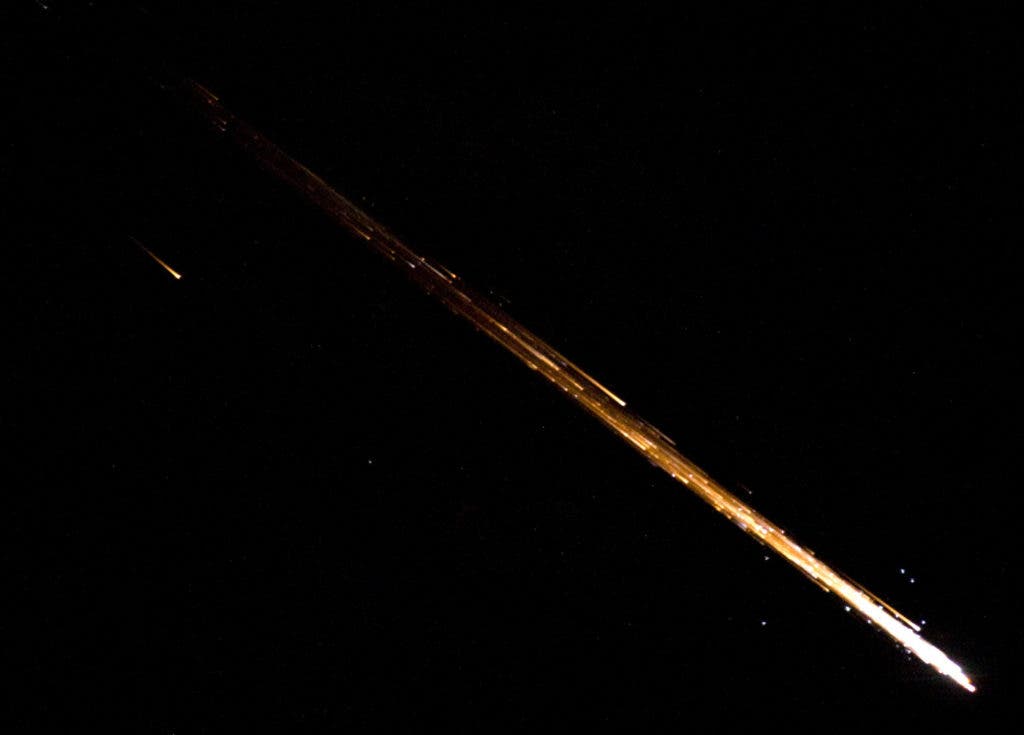Sometime in March, China’s first manned space station, Tiangong-1, is set to come crashing down on Earth. We don’t know precisely when, and we can’t tell exactly where either. But don’t start spending money on hardhats just yet — there’s an extremely small chance that the ship or any debris from it will actually hit anyone.

Image credits ESA / NASA.
Launched back in September of 2011, Tiangong-1 — full name Tiāngōng yīhào, “Heavenly Palace” — was China’s first manned space station. The craft represented this country’s first steps in space station technology, serving its maiden year as an unmanned craft, a platform on which the Chinese National Space Administration (CNSA) could test hardware and practice docking. Crews moved in in 2012 and 2013, including the country’s first female astronauts.
It was actually only meant to stay in operation until 2013 and then be replaced. After the last crew was brought back planet-side, however, CNSA decided to extend the operational life of Tiangong-1 by a further two years. The station was put in ‘sleep mode’ on a spin around the planet so that engineers could collect data on the longevity of key components while its orbit slowly decayed.
As far as decommissioning is concerned, however, Tiangong-1 certainly plans to go out with a bang.
Blaze of (uncontrolled) glory
Back in 2016, CNSA announced that it lost contact and control capabilities over the station. Still bleeding altitude, it will ultimately make an uncontrolled re-entry (fancy way of saying ‘crash down’) sometime this March. Several countries have been keeping tabs on the vessel, and according to estimates, it should end up somewhere between 43 degrees North and 43 degrees South — an area that’s mostly water.
Satellites and spacecraft fall on Earth all the time — mostly because we do such a poor job of not littering in space. All the junk, decommissioned craft, and other bits flying around Earth eventually drop to a low orbit, where atmospheric drag brings them down. But while most of that is small enough to burn up in the atmosphere, Tiangong-1 stands apart from all this mess due to its sheer size.
As a rule of thumb, engineers estimate that around 10% to 40% of a falling spaceship will make it through the atmosphere unburnt. Tiangong weighs in at around 8,506 kilograms (18,753 lbs) of heat-shield-covered goodness, so we’re potentially looking at around 850 to 3400 kilograms (1,873 to 7,495 lbs) of incoming spaceship. Compounding the problem is that China can’t nudge the station any longer, as controllers generally do with thruster-equipped vessels during an uncontrolled re-entry, and thus we have no power over where it eventually crash-lands. The station itself is quite compact, just 10.5 by 3.35 meters (34.4 by 10.9 ft), but it’s very difficult to tell how wide any debris will spread.

Image credits NASA, ESA / D. Jewitt (UCLA).
Now, while this may sound unpleasantly apocalyptic, it’s important to note that it’s not the first time a craft made an uncontrolled re-entry. It’s neither the biggest ship to do so, nor, arguably, is it the most dangerous one — in 1987, for example, a malfunctioning Soviet reconnaissance satellite crashed and spread nuclear material from its fission reactor all around Canada’s Great Slave Lake. Tiangong relies on solar panels, the clean energy that is clean even after it crash-lands.
It’s also important to note that the debris won’t necessarily stay in one piece and place — that 2,000 to 8,000 pounds of craft could very well be spread across a range of several square miles. Much larger and bulkier ships crashed without causing any real damage. Phobos-Grunt, a 13,600 kg (30,000 lbs) Russian spacecraft aimed at Mars safely crashed into the Pacific in 2012. Skylab, the largest ship to make an uncontrolled reentry with its 72,500 kg (160,000 lbs) frame, fell in the Australian Outback, damaging some buildings, killing a cow, and incurring a littering fine for the US.
So if you were planning on getting hit by Tiangong, your chances don’t look good. The Verge’s Loren Grush says there’s a 1 in 10,000 chance for anyone to be hit by a fragment — which is about as much as your odds of catching a lightning bolt sometime in your life, according to NOAA.
In fact, there’s only one person ever known to have probably been hit by space debris in the 50 or so years we’ve been launching rockets. Her name is Lottie Williams, and in 1997, while out for a walk, she was hit in the shoulder by a 15.2 (6 in) long metal fragment. It wasn’t ever identified as having come from a rocket, but NASA says the incident happened around the time and place of the re-entry and breakup of a second-stage Delta rocket.
So the odds, as they say, look solidly in your favor. And hey, if you do get unlucky and catch a piece of Tiangong-1, you’ll at least be famous. But maybe that’s not really worth it.
In the meantime, virtually all state agencies will be watching and learning all they can from the re-entry. A group of such agencies, the IADC, will be working together to track and record the station’s fall and use the data to refine our prediction models — meaning we’ll have a much better idea of how stuff crashes down in the future. Sadly, right now they won’t be able to offer any type of warning — they’ll likely be able to say when it comes down with some degree of accuracy a few hours before it happens, but all bets are currently off for ‘where’.


